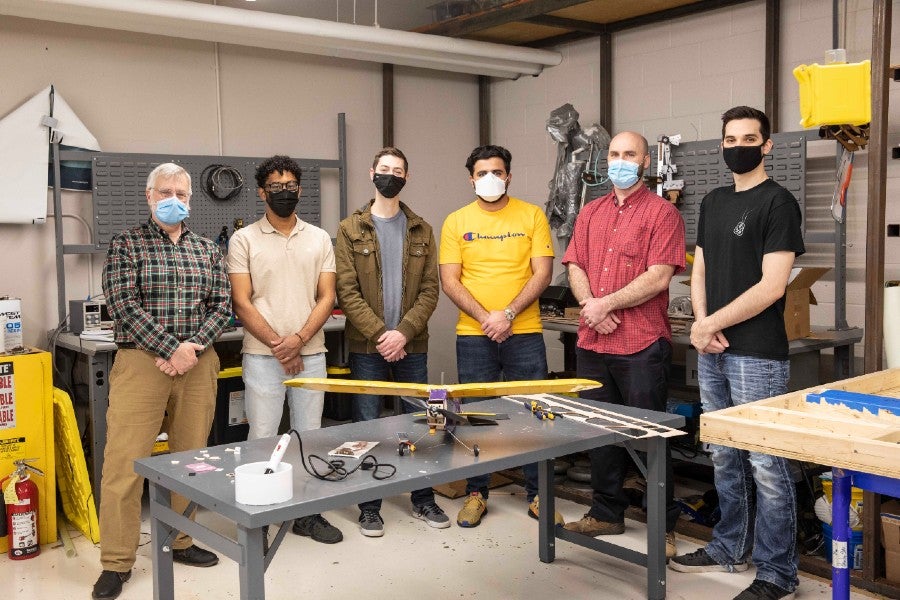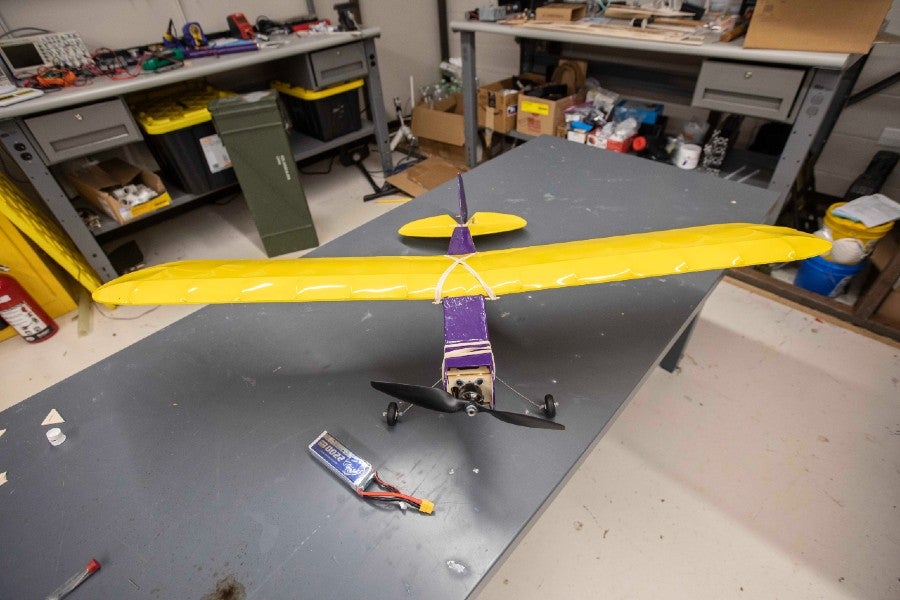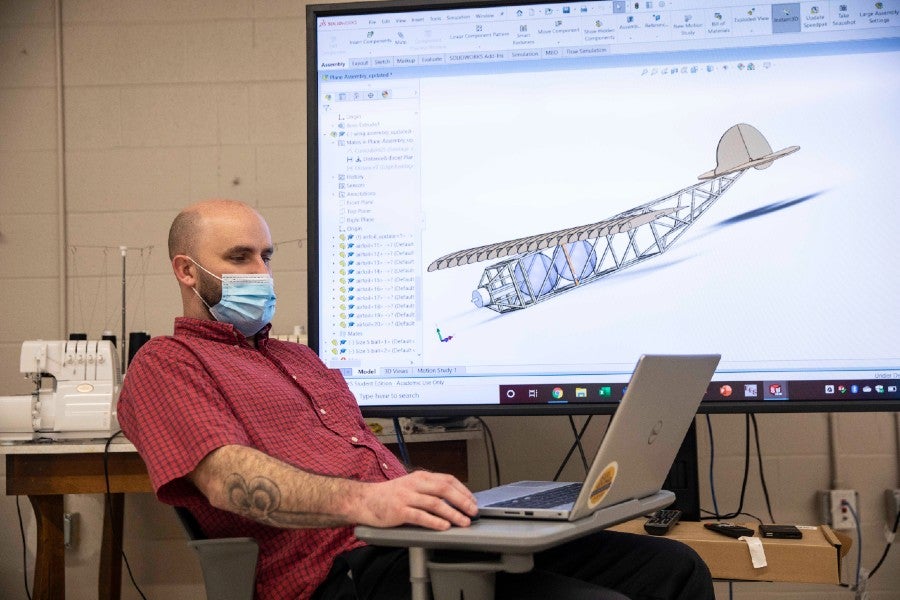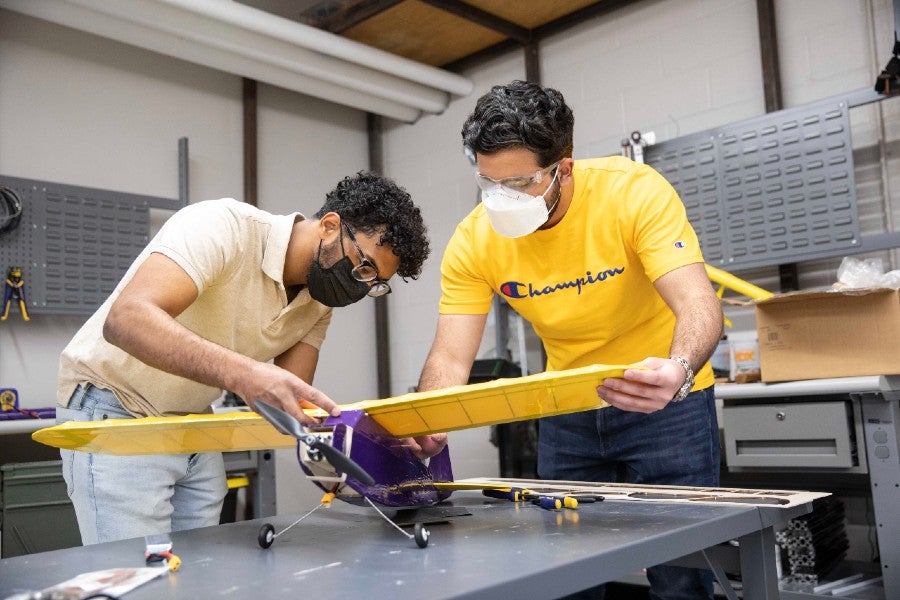Lipscomb student design team takes on the Aero Design Challenge
Interest from students spurred university to enter its first team in the national competition to design an aircraft.
Janel Shoun-Smith | 615.966.7078 |

The members of the Aero Design Challenge senior project team with their advisor and the prototype model of their aircraft.
For the first time at Lipscomb University, a group of senior engineering majors are competing in the Society of Automotive Engineers’ Aero Design Challenge, working to build an aircraft with a 8-foot wingspan and enough cargo space to hold a soccer ball.
As with senior design engineering projects of the past, such as the exoskeleton project in 2019, participating in the Aero Challenge was spurred by student interest, said Saad Rajput, a senior mechanical engineering major from Nashville and the team leader for the project.
“Mohamed Sayid and myself were talking during my junior year and discovered we both wanted to do an aerospace-related project,” said Rajput. “Mohammed came up with the idea to build a remote control aircraft model and we found the SAE national competition. We proposed the idea to Dr. (Fort) Gwinn (associate dean) and it met the criteria for a senior design project.”
All five of the students on the team—the others are Grant Voss, Timothy Smidt and Chase Weimer—are passionate about aerospace in some form or fashion, Rajput said. They are all mechanical, electrical or computer engineering majors.

This is a prototype model of the aircraft the team will eventually build with an eight-foot wingspan.
The Aero Design Challenge aircraft must be able to take off and land while carrying either a spherical or cube-shaped payload in its cargo bay.
“One of the main objectives of this project is to challenge and prepare students to meet deadlines,” said Rajput. “This competition is heavily based on a design report with an oral presentation, usually presented in front of a large crowd. You may have great ideas in your head, but if you can’t communicate with others, they are not going anywhere.”
As with just about all large gatherings during the Covid-19, the Aero Challenge reverted to digital presentations, requiring the Lipscomb team to have their design materials and presentations submitted by late January. In normal years, the aircraft would be constructed, and teams from across the nation would gather in March for their validation flights.
This year, Rajput says his team plans to construct their aircraft and take it for a test flight here in Nashville in time to present it at Lipscomb’s on-campus Student Scholars Symposium in April.

Computer assisted design is used in many senior projects in engineering.
To design a working aircraft, the team must figure out the proper wingspan and the best airfoil design to achieve the most lift and a smooth flight, to ensure it can carry the payload weight safely, Rajput said. The students must design a propulsion system, install proper landing gear and calculate the drag on the aircraft using aerodynamics computational software, among other tasks, he said.
“The project is a combo of physics, meeting deadlines and making reports. If you combine all those things, that is what the real world is like,” he said.
Lipscomb does not have an aerospace engineering major, meaning the senior design team had to do a lot of research outside of class to create an aircraft from scratch, said Gwinn. They were benefited by the fact that several of the engineering faculty—including Gwinn and Dean David Elrod—have worked professionally in the aerospace field, he said.
“This competition required a higher degree of motivation from these students,” Gwinn said.
Rajput was certainly game for the challenge. “That’s the whole point of senior design: to challenge yourself with something you have never done before. And if you are successful, great; and if not, you still learn from the experience,” he said.
“What we are setting up is a great example for other teams to follow. They can learn from our experience, and make a better model for future competitions. This is the best aerospace experience you can get.”

THE TEAM PLANS TO TAKE THE AIRCRAFT FOR A TEST FLIGHT IN TIME TO PRESENT IT AT LIPSCOMB’S ON-CAMPUS STUDENT SCHOLARS SYMPOSIUM IN APRIL.